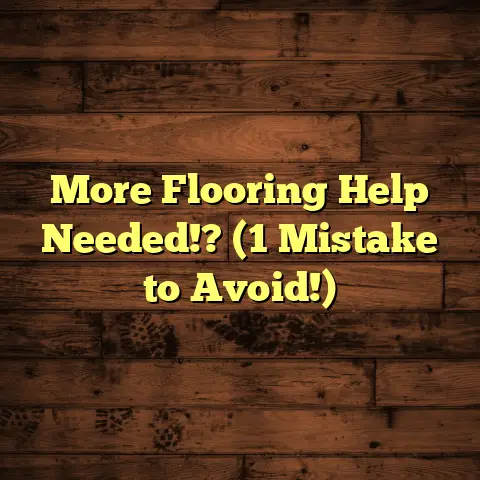Laminate Floor Cleaner? (3 DIY Recipes Now!)
You don’t need expensive commercial cleaners to keep your laminate floors sparkling clean; in fact, the best solutions are likely already in your kitchen cabinet! I’ve seen it time and again in my years as a flooring contractor: homeowners spending a fortune on fancy cleaners when simple, DIY solutions work just as well, if not better.
1. Understanding Laminate Flooring
Let’s get down to basics. What exactly is laminate flooring? It’s a synthetic flooring that’s become incredibly popular due to its durability, affordability, and realistic wood-look. Unlike hardwood, which is solid wood, laminate is made up of several layers:
- The Base Layer: This provides stability and resistance to moisture.
- The Core Board: Usually made of high-density fiberboard (HDF) or medium-density fiberboard (MDF), this gives the flooring its strength and impact resistance.
- The Decorative Layer: This is a photographic image that gives the laminate its wood, stone, or tile appearance.
- The Wear Layer: A transparent top layer that protects the decorative layer from scratches, stains, and fading.
This layered construction is what makes laminate different from hardwood or vinyl. Hardwood is, well, hard wood. Vinyl is a resilient flooring made of PVC. Laminate, on the other hand, is a composite material.
Because of this composition, laminate requires special care. You can’t treat it like a hardwood floor that can be refinished, nor can you soak it like some types of vinyl.
2. The Importance of Using the Right Cleaner
Why can’t you just use any old cleaner on laminate? I’ve seen the damage firsthand. Using the wrong cleaner can lead to a whole host of problems:
- Swelling: Laminate’s core board is susceptible to water damage. Excessive water can seep into the seams and cause the boards to swell and warp.
- Discoloration: Harsh chemicals can strip the protective wear layer, leading to fading and discoloration.
- Residue Buildup: Some cleaners leave behind a sticky residue that attracts dirt and makes your floors look dull.
- Scratching: Abrasive cleaners or scrub brushes can scratch the wear layer, making your floors look worn and damaged.
Common Cleaning Mistakes I’ve Seen:
- Using Too Much Water: This is the biggest culprit. Laminate is not waterproof.
- Using Harsh Chemicals: Bleach, ammonia, and other strong chemicals can damage the wear layer.
- Using Abrasive Cleaners: Steel wool, scouring pads, and even some powdered cleaners can scratch the surface.
- Not Drying the Floor Properly: Leaving water to sit on the surface can lead to water damage.
According to the North American Laminate Flooring Association (NALFA), proper cleaning and maintenance are essential for extending the life of your laminate floors. They recommend using cleaners specifically designed for laminate or gentle, pH-neutral solutions.
3. Benefits of DIY Cleaners
So, why go the DIY route? I’m a big fan, and here’s why:
- Cost-Effective: You likely already have the ingredients in your pantry.
- Eco-Friendly: You’re reducing your reliance on harsh chemicals and plastic bottles.
- Customizable: You can adjust the recipes to suit your needs and preferences.
- Safer for Kids and Pets: You’re avoiding potentially harmful chemicals that could be ingested or inhaled.
Plus, there’s something satisfying about knowing exactly what’s going onto your floors. No mystery ingredients, no hidden toxins. Just simple, effective cleaning power.
4. DIY Recipe #1: Vinegar and Water Solution
This is my go-to cleaner for everyday maintenance. It’s simple, effective, and incredibly cheap.
Recipe:
- 1/2 cup white vinegar
- 1 gallon warm water
- Optional: 5-10 drops of your favorite essential oil (lemon, lavender, or tea tree are great choices)
Instructions:
- Combine the vinegar and water in a bucket.
- Add essential oils, if desired.
- Dampen a microfiber mop or cloth with the solution.
- Wring out the mop or cloth thoroughly to avoid excess water.
- Mop the floor in sections, rinsing the mop or cloth as needed.
- Dry the floor with a clean, dry microfiber cloth.
The Science Behind It:
Vinegar is a natural disinfectant and degreaser. Its acidity helps to cut through grime and dirt without leaving behind a residue. It also helps to kill bacteria and mold. The acidity of vinegar is generally around 2.4 pH.
5. DIY Recipe #2: Baking Soda and Water Paste
Got a stubborn stain? This baking soda paste is your secret weapon.
Recipe:
- 1/4 cup baking soda
- 2-3 tablespoons water
Instructions:
- Mix the baking soda and water in a small bowl to form a thick paste.
- Apply the paste to the stain.
- Let it sit for 5-10 minutes.
- Gently scrub the stain with a soft cloth.
- Wipe away the paste with a damp cloth.
- Dry the area with a clean, dry cloth.
The Science Behind It:
Baking soda is a mild abrasive that can help to lift stains without scratching the laminate. It’s also a natural deodorizer. The pH of baking soda is around 8.3, which is mildly alkaline.
Important Note: Always test the paste in an inconspicuous area first to make sure it doesn’t damage the finish.
6. DIY Recipe #3: Essential Oil Cleaner
Want to clean and freshen your floors at the same time? This essential oil cleaner is the perfect solution.
Recipe:
- 1 gallon warm water
- 1 tablespoon Castile soap (unscented)
- 10-15 drops of essential oil (lemon, tea tree, eucalyptus, or lavender)
Instructions:
- Combine the water, Castile soap, and essential oils in a bucket.
- Dampen a microfiber mop or cloth with the solution.
- Wring out the mop or cloth thoroughly to avoid excess water.
- Mop the floor in sections, rinsing the mop or cloth as needed.
- Dry the floor with a clean, dry microfiber cloth.
The Benefits of Essential Oils:
- Antibacterial Properties: Tea tree, eucalyptus, and lemon oils have natural antibacterial properties.
- Natural Fragrance: Essential oils leave behind a pleasant, natural scent.
- Mood Boosting: Some essential oils, like lavender and lemon, can have mood-boosting effects.
Specific Essential Oil Options:
- Lemon: Brightens and disinfects.
- Tea Tree: Antiseptic and antifungal.
- Eucalyptus: Cleansing and invigorating.
- Lavender: Calming and relaxing.
7. How to Properly Clean Laminate Floors
Now that you have the recipes, let’s talk about technique. Here’s my step-by-step guide to cleaning laminate floors:
Tools You’ll Need:
- Microfiber mop or cloth
- Spray bottle (for spot cleaning)
- Bucket
- Vacuum or broom
- Dry microfiber cloth
Step-by-Step Guide:
- Prepare the Floor: Vacuum or sweep the floor to remove loose dirt and debris.
- Mix Your Cleaner: Choose one of the DIY recipes and mix it according to the instructions.
- Dampen Your Mop or Cloth: Dip your microfiber mop or cloth into the cleaning solution and wring it out thoroughly. The key is to use as little water as possible.
- Mop the Floor: Mop the floor in sections, overlapping each stroke slightly.
- Spot Clean: For stubborn stains, spray the area with the cleaning solution and let it sit for a few minutes before wiping it away.
- Dry the Floor: Use a clean, dry microfiber cloth to dry the floor immediately after mopping. This will prevent water spots and streaks.
Tips for Routine Maintenance:
- Vacuum or sweep regularly: This will prevent dirt and debris from scratching the surface.
- Use doormats: Place doormats at entrances to trap dirt and moisture.
- Clean up spills immediately: The longer a spill sits, the more likely it is to stain.
- Use furniture pads: Protect your floors from scratches by using furniture pads under chairs and tables.
Addressing Specific Types of Stains or Spills:
- Grease: Use a baking soda paste or a mixture of dish soap and water.
- Ink: Try rubbing alcohol or nail polish remover.
- Pet Accidents: Clean up the mess immediately and disinfect the area with a vinegar and water solution.
- Sticky Residue: Use a mixture of warm water and a few drops of dish soap.
8. Common Mistakes to Avoid When Cleaning Laminate Floors
I’ve seen it all, and I want to help you avoid these common pitfalls:
- Using Too Much Water: Remember, laminate is not waterproof.
- Using Steam Mops: Steam can penetrate the seams and cause the core board to swell.
- Using Abrasive Cleaners or Scrub Brushes: These can scratch the wear layer.
- Leaving Water to Sit on the Surface: Always dry the floor immediately after mopping.
- Ignoring Manufacturer’s Instructions: Always check the manufacturer’s recommendations for cleaning and maintenance.
Alternatives and Corrections:
- If you’ve used too much water: Dry the floor immediately with a clean, dry cloth. You can also use a fan to help speed up the drying process.
- If you’ve scratched the surface: Unfortunately, scratches can be difficult to remove. You may be able to minimize their appearance with a laminate repair kit.
- If you’ve used the wrong cleaner: Rinse the floor with clean water and dry it thoroughly. Then, switch to a laminate-safe cleaner.
9. Conclusion
Maintaining beautiful laminate flooring doesn’t have to be a complicated or costly endeavor. With these simple DIY recipes and techniques, you can keep your floors sparkling clean and looking their best for years to come.
I encourage you to try these DIY recipes and experience the satisfaction of using natural, effective cleaning solutions. Not only will you save money and reduce your environmental impact, but you’ll also have the peace of mind knowing that you’re using safe and gentle products on your floors.
10. Additional Resources
Want to learn more about laminate care and DIY cleaning? Here are some helpful resources:
- North American Laminate Flooring Association (NALFA): https://www.nalfa.com/ (This is a good resource for general information on laminate flooring.)
- The Spruce: https://www.thespruce.com/ (This website offers a wealth of information on home cleaning and maintenance.)
- DIY Network: https://www.diynetwork.com/ (This website has tutorials and tips for a variety of home improvement projects, including flooring.)
Happy cleaning! And remember, a little bit of prevention and regular maintenance can go a long way in keeping your laminate floors looking their best.





